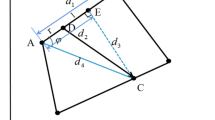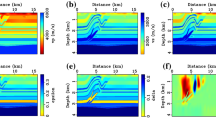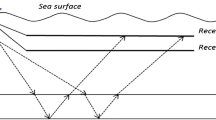Abstract
Elastic wave imaging with ocean-bottom four-component (4C) seismic data offers unique advantages in offshore oil and gas exploration, but for sparse ocean-bottom node/ocean-bottom seismometer (OBN/OBS) 4C seismic data, the problems of imaging acquisition footprints, poor phase continuity, and low signal-to-noise (S/N) persist. Pressure data acquired by towed streamer (TS) are dense and can be used in elastic imaging of sparse OBN/OBS data using acoustic–elastic coupled equations (AECEs). Based on the AECEs, we propose a novel method for elastic wave joint imaging of dense TS and sparse OBN/OBS seismic data, including joint elastic reverse-time migration (J-ERTM) and joint elastic least-squares reverse-time migration (J-ELSRTM), to solve the above problems in elastic imaging with sparse OBN/OBS data. J-ERTM of TS and OBN/OBS data can address the problem of imaging acquisition footprints, but with low S/N ratio. J-ELSRTM uses Hessian information and can theoretically suppress the negative influences caused by sparse acquisition, thereby obtaining better images than J-ERTM with higher S/N ratio. The results of synthetic and field data experiments show that our method is of prime importance for addressing the elastic wave imaging problems of sparse OBN/OBS data in deep-water oil and gas seismic exploration.















Similar content being viewed by others
References
Caldwell, J. (1999). Marine multicomponent seismology. The Leading Edge, 18(11), 1274–1282.
Chen, K., & Sacchi, M. D. (2017). Elastic least-squares reverse time migration via linearized elastic full waveform inversion with pseudo-Hessian preconditioning. Geophysics, 82(5), 1–89.
Duan, Y., Guitton, A., & Sava, P. (2017). Elastic least-squares reverse time migration. Geophysics, 82(2), 4152–4157.
Feng, Z., & Schuster, G. T. (2017). Elastic least-squares reverse time migration. Geophysics, 82(2), S143–S157.
Gaiser, J. E. (1998). Compensating OBC data for variations in geophone coupling. SEG Technical Program Expanded Abstracts, pp. 1429–1432.
Gaiser, J., Moldoveanu, N., Macbeth, C., et al. (2001). Multicomponent technology: the players, problems, applications, and trends: Summary of the workshop sessions. The Leading Edge, 20(9), 974–977.
Granger, P. Y., Manin, M., Boelle, J. L., et al. (2005). Autonomous 4C Nodes used in infill areas to complement streamer data, deepwater case study. SEG Technical Program Expanded Abstracts, 24(1), 2668–2672.
Grion, S., Exley, R., Manin, M., et al. (2007). Mirror imaging of OBS data. First Break, 25, 37–42.
He, H., Zhou, H. Z., & Fu, D. D. (2002). Multicomponent seismic exploration in Ying Ge Hai Basin. The Leading Edge, 21(9), 914–920.
Kragh, E., Muyzert, E., Curtis, T., et al. (2010). Efficient broadband marine acquisition and processing for improved resolution and deep imaging. The Leading Edge, 29(4), 464–469.
Langhammer, J., Eriksrud, M., & Nakstad, H. (2010). Performance characteristics of 4C fiber optic ocean bottom cables for permanent reservoir monitoring. SEG Technical Program Expanded Abstracts, pp. 66–70.
Muijs, R., Robertsson, J., & Holliger, K. (2004). Data-driven adaptive decomposition of multicomponent seabed recordings. Geophysics, 69(5), 1329–1337.
Olofsson, B., Probert, T., & Kommedal, J. H. (2003). Azimuthal anisotropy from the Valhall 4C 3D survey. The Leading Edge, 22(12), 1228–1235.
Paslay, L., Pavey, J., & Wipff, F. P. (1956). Water borne means for making seismic surveys. US, US2729300A.
Proffitt, J. M. (1991). A history of innovation in marine seismic data acquisition. The Leading Edge, 10(3), 24–30.
Ravasi, M., & Curtis, A. (2013). Elastic imaging with exact wavefield extrapolation for application to ocean-bottom 4C seismic data. Geophysics, 78(6), S265–S284.
Ren, Z., Liu, Y., & Sen, M. (2017). Least-squares reverse time migration in elastic media. Geophysical Journal International, 208(2), 1103–1125.
Schalkwijk, K. (2001). Decomposition of multicomponent ocean bottom data into P- and S-waves. Ph.D. thesis, Delft University of Technology.
Sha, Z., Zhang, M., Zhang, G., et al. (2015). Using 4C OBS to reveal the distribution and velocity attributes of gas hydrates at the northern continental slope of South China Sea. Applied Geophysics, 12(4), 555–563.
Sheriff, R. E., & Geldart, L. P. (1995). Exploration seismology (2nd ed., pp. 1–32). Cambridge University Press.
Shi, X., Mao, W., & Li, X. (2020). Elastic Gaussian-beam migration for four-component ocean-bottom seismic data. Geophysics, 85(1), S11–S19.
Sønneland, L., Hansen, J. O., Hutton, G., et al. (1998). Reservoir characterization using 4C seismic and calibrated 3D AVO. SEG Technical Program Expanded Abstracts, 17(1), 932–935.
Sun, M., **, S., & Yu, P. (2021). Elastic least-squares reverse-time migration based on a modified acoustic-elastic coupled equation for OBS four-component data. IEEE Transactions on Geoscience and Remote Sensing, 99, 1–11.
Wang, X., Han, Y., Liu, C., et al. (2015). Research on improving conventional marine seismic streamer data imaging quality using OBS data from Northern South China Sea. Journal of Applied Geophysics, 116, 10–16.
Wang, X., **a, C., & Liu, X. (2012). A case study: imaging OBS multiples of South China Sea. Marine Geophysical Research, 33, 89–95.
Yu, P., & Geng, J. (2020). Analytic acoustic-elastic coupled equations and their application in vector-wave-based imaging of ocean bottom 4C data. Pure and Applied Geophysics, 177, 961–975.
Yu, P., Geng, J., Li, X., et al. (2016). Acoustic-elastic coupled equation for ocean bottom seismic data elastic reverse-time migration. Geophysics, 81(5), S333–S345.
Yu, P., Geng, J., & Ma, J. (2018). Vector-wave-based elastic reverse time migration of ocean-bottom 4C seismic data. Geophysics, 83(4), S333–S343.
Acknowledgements
This research was funded by the National Key Research and Development Program of China Project (grant no. 2018YFC0310104), Natural Science Found of Jiangsu Province (grant no. BK20201318), National Natural Science Foundation of China (grant no. 42074149), and Fundamental Research Funds for the Central Universities (grant no. B210202133). The datasets for this research can be accessed at https://zenodo.org/record/4420518.
Author information
Authors and Affiliations
Corresponding author
Additional information
Publisher’s Note
Springer Nature remains neutral with regard to jurisdictional claims in published maps and institutional affiliations.
Appendices
Appendix A: Improved AECEs in 2D Isotropic Media
Yu et al. (2016) give the first-order AECEs in 2D isotropic media as follows:
In this expression, \({\mathbf{u}} = \left( {u_{x} ,u_{z} } \right)^{T}\) is the particle velocity, \(\rho\) is the density, and \({{\varvec{\uptau}}} = \left( {\tau_{xx} ,\tau_{zz} ,\tau_{xz} } \right)^{T}\) is the stress, \(p_{s} {\kern 1pt} {\kern 1pt}\) represent the synthesized pressure. However, there is some redundancy in the original 2D AECEs. Thus, we define
Here, \(\tau_{n}^{s}\) and \(\tau_{s}^{s}\) are the redefined normal and deviatoric stress components in this paper.
The improved 2D AECEs can be given by
The improved AECEs eliminate redundant terms, which improves the calculation efficiency. The new equations can be used for elastic wave imaging of ocean-bottom multicomponent data.
Appendix B: J-ELSRTM of TS and OBN/OBS Data
Based on the AECEs, the misfit function, the adjoint equations, and the adjoint sources are defined in Eqs. (6)–(8), respectively. RTM imaging can then be derived:
According to optimization theory, the RTM image mmig and the reflectivity model mref satisfy the least-squares Newton equation when the minimum of the objective function (6) is obtained:
where L represents the first-order Born operator, which is the first partial derivative of seismic data with respect to the parameters, while \({\mathbf{L}}^{T} {\mathbf{L}}\) represents the Hessian operator, which is the second-order partial derivative of E(m) with respect to the parameters.
The Hessian operator \({\mathbf{L}}^{T} {\mathbf{L}}\) in the J-ELSRTM of TS and OBN/OBS seismic data simultaneously contains the pressure and displacement terms:
\({\mathbf{L}}_{u} ,{\kern 1pt} {\kern 1pt} {\mathbf{L}}_{p}\) are the sensitivity kernels with respect to displacement and pressure. This illustrates that J-ELSRTM of TS and OBN/OBS seismic data is theoretically more likely to take into account the influences of the pressure component on updating parameters. Since the Hessian matrix is severely ill conditioned, direct calculation of the reverse Hessian operator is not feasible. As a result, we plan to take advantage of the truncated Gauss–Newton algorithm to include Hessian information indirectly into multicomponent imaging, using the following algorithm:
Algorithm | |
|---|---|
Set \({\mathbf{x}}_{0} = 0\) and \({\mathbf{r}}_{0} = {\mathbf{H}}\left( {\mathbf{m}} \right){\mathbf{x}}_{0} - {\mathbf{b}},{\kern 1pt} {\kern 1pt} {\kern 1pt} {\mathbf{p}}_{0} = - {\mathbf{r}}_{0} ,{\kern 1pt} {\kern 1pt} k = 0\) While \({\mathbf{r}}_{k} \ne 0\) do \(\begin{gathered} \alpha_{k} = \frac{{{\mathbf{r}}_{k}^{T} {\mathbf{r}}_{k} }}{{{\mathbf{p}}_{k}^{T} {\mathbf{H}}\left( {\mathbf{m}} \right){\mathbf{p}}_{k} }} = \frac{{{\mathbf{r}}_{k}^{T} {\mathbf{r}}_{k} }}{{{\mathbf{p}}_{k}^{T} \left[ {{\mathbf{L}}^{T} \left( {{\mathbf{Lp}}_{k} } \right)} \right]}}{\kern 1pt} {\kern 1pt} , \hfill \\ x_{k + 1} = x_{k} + \alpha_{k} {\mathbf{p}}_{k} , \hfill \\ {\mathbf{r}}_{k + 1} = {\mathbf{r}}_{k} + \alpha_{k} {\mathbf{H}}\left( {\mathbf{m}} \right){\mathbf{p}}_{k} = {\mathbf{r}}_{k} + \alpha_{k} \left[ {{\mathbf{L}}^{T} \left( {{\mathbf{Lp}}_{k} } \right)} \right], \hfill \\ \beta_{k + 1} = \frac{{{\mathbf{r}}_{k + 1}^{T} {\mathbf{r}}_{k + 1} }}{{{\mathbf{r}}_{k}^{T} {\mathbf{r}}_{k} }}, \hfill \\ {\mathbf{p}}_{k + 1} = - {\mathbf{r}}_{k + 1} + \beta_{k + 1} {\mathbf{p}}_{k} , \hfill \\ k = k + 1, \hfill \\ \end{gathered}\) End while Return |
In this algorithm, \({\mathbf{x}}_{0}\) denotes the initial LSM images, which is set to be zero. \({\mathbf{H}}\) is the Hessian operator, and \({\mathbf{b}}\) is the RTM result. \({\mathbf{r}}_{0}\) and \({\mathbf{p}}_{0}\) are intermediary variables; \(\alpha\) and \(\beta\) are the step length. In each iteration, the key calculations are spent in performing the demigration \({\mathbf{Lp}}_{k}\) and migration \({\mathbf{L}}^{T} \left( {{\mathbf{Lp}}_{k} } \right)\) processes. Either demigration or migration processes can be realized with only one-time wavefield simulation. When the minimum of the 4C misfit function is achieved, J-ELSRTM images can be obtained.
Rights and permissions
About this article
Cite this article
Yu, P., Sun, M. Acoustic–Elastic Coupled Equations for Joint Elastic Imaging of TS and Sparse OBN/OBS Data. Pure Appl. Geophys. 179, 311–324 (2022). https://doi.org/10.1007/s00024-021-02899-5
Received:
Revised:
Accepted:
Published:
Issue Date:
DOI: https://doi.org/10.1007/s00024-021-02899-5




